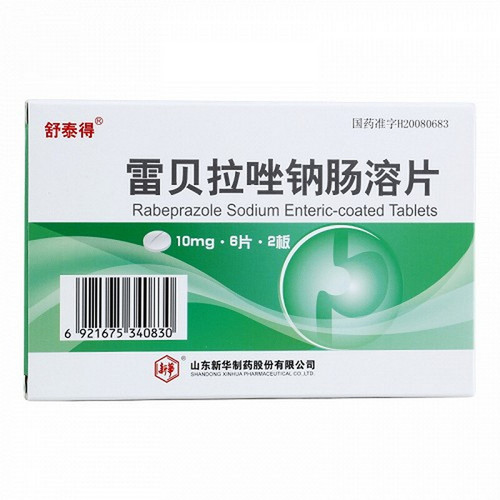Product Overview
[Generic Name]
Rabeprazole Sodium Enteric-Coated Capsules
[Drug Name]
Libeprazole Rabeprazole Sodium Enteric-Coated Capsules
[Main Ingredients]
The main ingredient of this product is rabeprazole sodium.
[Indications]
This product is indicated for gastric ulcers, duodenal ulcers, anastomotic ulcers, reflux esophagitis, and Zollinger-Ellison syndrome (gastrinoma).
[Dosage and Administration]
Generally, adults take 10 mg (1 capsule) orally once daily. Depending on the condition, 20 mg (2 capsules) can be taken orally once daily. Generally, the maximum dosage for gastric ulcers, anastomotic ulcers, and reflux esophagitis is 8 weeks, and for duodenal ulcers, the maximum dosage is 6 weeks.
[Properties]
This product is an enteric-coated capsule containing an off-white or pale yellow powder.
[Adverse Reactions]
1. It was reported that adverse reactions occurred in 22 cases (1.77%) out of a total of 1,244 cases. In addition, 82 cases (6.59%) were reported to have abnormal clinical examination values (at the time of approval). 2. Serious adverse reactions (similar drugs) (1) Shock: There are reports that similar drugs (omeprazole, lansoprazole) occasionally cause allergic reactions or shock. Therefore, when abnormal conditions are observed, the drug should be discontinued and appropriate measures should be taken. (2) Hemogram: There are reports that similar drugs (omeprazole, lansoprazole) occasionally cause pancytopenia, thrombocytopenia, agranulocytosis, and hemolytic anemia. In addition, granulocytopenia and anemia may sometimes be seen. Therefore, when such abnormal conditions occur, the drug should be discontinued and appropriate measures should be taken. 3. Serious adverse reactions (foreign cases) Visual impairment: There are reports of visual impairment caused by the use of similar drugs (omeprazole) abroad. 4. Other adverse reactions (1) Allergy: Rash and urticaria occur at 0.1% to 5% or less, and itching occurs at 0.1% or less. If such symptoms occur, the drug should be discontinued. (2) Blood: Erythropenia, leukopenia, leukocytosis, eosinophilia, neutrophilia, and lymphocytopenia occur at 0.1% to 5% or less. Regular hematological examinations should be performed during medication. If abnormalities are found, appropriate measures such as discontinuation of medication should be taken. (3) Liver: Elevated AST, ALT, ALP, γ-GTP, LDH, and total bilirubin occur at 0.1% to 5% or less. Regular blood biochemistry examinations should be performed during medication. If abnormalities are found, appropriate measures such as discontinuation of medication should be taken. (4) Circulatory system: Palpitations occur at 0.1% or less. (5) Digestive system: Constipation, diarrhea, and abdominal distension occur in less than 0.1% to 5% of cases, and nausea, lower abdominal pain, and indigestion occur in less than 0.1%. (6) Psychoneural system: Headache occurs in less than 0.1% to 5% of cases, and dizziness, drowsiness, weakness in the limbs, sensory insensitivity, decreased grip strength, slurred speech, and staggering gait occur in less than 0.1%. There is a report of one case of cirrhosis of the liver with weakness in the limbs, sensory insensitivity, decreased grip strength, slurred speech, and staggering gait. In addition, it has been reported that one case of cirrhosis of the liver with a history of hepatic encephalopathy abroad experienced mental confusion, loss of cognitive ability, and drowsiness. (7) Other: Edema, elevated total cholesterol/neutral fat/BUN, and proteinuria occur in less than 0.1% of cases, and fatigue occurs in less than 0.1%.
[Precautions]
1. The following patients should use with caution: (1) Patients with a history of drug allergy (2) Patients with liver dysfunction [patients with cirrhosis have reported adverse reactions to the psychiatric and neurological systems (see "Adverse Reactions") (3) Elderly patients 2. When administering this drug, in cases of severe disease or recurrent or refractory cases, 20 mg can be administered once a day. 3. This drug may mask symptoms caused by gastric cancer, so it should be administered only after it is confirmed that it is not a malignant tumor. 4. During treatment, the patient's clinical dynamics should be closely observed, and the dosage should be controlled to the minimum required for treatment according to the condition. Since there is no sufficient long-term use experience with this drug, it is not suitable for maintenance treatment. 5. This drug is an enteric-coated microcapsule. It should be swallowed when taken, rather than chewed or crushed.
[Interactions]
1. Digoxin clinical symptoms or treatment measures: Sometimes it can cause an increase in digoxin blood concentration. Mechanism of action or risk factors: The absorption of digoxin is promoted due to the increase in gastric pH. 2. Clinical symptoms or treatment measures for phenytoin: Similar drugs (omeprazole) have been reported to cause delayed metabolism or excretion. 3. Clinical symptoms or treatment measures for antacids containing aluminum hydroxide gel or magnesium hydroxide: It has been reported that the mean plasma concentration area under the curve for phenytoin decreased by 8% and 6%, respectively, when taken concurrently with an antacid and one hour after taking the antacid, compared to when the drug was given alone.
[Specification]
7 capsules/box
[Approval Number]
National Medicine Standard H20041057
[Manufacturer]
Livzon Pharmaceutical Factory, Livzon Group








